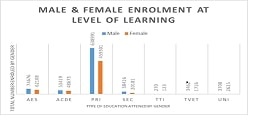Analysing Barriers to Girls’ Education Outcomes in South Sudan

Abstract:
References:
[1] UNMISS, 2019
South Sudan Peace implementation report to Security Council –Juba South https://www.securitycouncilreport.org/atf/cf/%7B65BFCF9B-6D27-4E9C-8CD3-CF6E4FF96FF9%7D/s_res_2459.pdf.
[2] UNOCHA South
Sudan, 2022. South Sudan humanitarian needs overview.
https://reliefweb.int/report/south-sudan/south-sudan-humanitarian-snapshot-march-2022 .
[3] South Sudan Logistics Cluster 2021. concept of operation. Juba:
https://reliefweb.int/report/south-sudan/south-sudan-logistics-cluster-concept-operations-march-2021 .
[4] Ssekamwa, J.
C., and Lugumba, S. M. E. 2001. A history of education in East Africa. Fountain
Pub Limited.
[5] Cyprian Amitabh
and Martha Nyantiop Agoot 2021. Determinants of disparities in primary school
enrolment in South Sudan. https://www.tandfonline.com/doi/full/10.1080/2331186X.2021.1989996
[6] Ministry of general
education, science and instruction, 2015. Annual statistical report.
[7] World Bank Annual
Report, 2022, Count Me in! improving education outcomes for girls and young
women.
[8] https://issuu.com/afaquirworldbankgroup/docs/countmein_education_brochure_10.10.
1_final_spread .
[9] Sharjeel Arif, 2021.
Cash transfers explained: how cold hard cash is beating stereotypes, hunger,
and poverty: https://www.concernusa.org/story/cash-transfers-explained .
[10] Herz, B., Herz, B.
K., and Sperling, G. B. .2004. What works in girls' education: Evidence and
policies from the developing world. Council on foreign relations.
[11] Vavrus, F. 2002.
Uncoupling the articulation between girls' education and tradition in Tanzania.
Gender and Education, 14(4), 367-389.
[12] Kirk, J., and Sommer,
M. 2006. Menstruation and body awareness: linking girls’ health with girls’
education. Royal Tropical Institute (KIT), Special on Gender and Health,
1(3),
1-22.
[13] David K Evans, and Amina
Mendez Acosta,.2021. Education in Africa: What Are We Learning? Journal of
African Economies, Volume 30, Issue 1, Pages 13–54, https://doi.org/10.1093/jae/ejaa009
[14] Roby, J. L., Lambert,
M. J., and Lambert, J. 2009. Barriers to girls' education in Mozambique at
household and community levels: An exploratory study. International Journal
of Social Welfare, 18(4), 342-353.
[15] Haugen, C. S., Klees,
S. J., Stromquist, N. P., Lin, J., Choti, T., and Corneilse, C. 2014.
Increasing the number of female primary school teachers in African countries:
Effects, barriers and policies. International Review of Education, 60,
753-776.
[16] Winthrop, R., and
McGivney, E. 2015. Raising the global ambition for girls’ education. In Women
and Girls Rising,
pp. 287-296). Routledge.
[17] Godfrey N. Brown, 1964.
British Educational
Policy in West and Central Africa. The Journal of Modern African Studies,
Volume 2, Issue 3, pp. 365–377, DOI: https://doi.org/10.1017/S0022278X00004328 .
[18] Katundano, T. 2020.
Cultural Practices in Africa: Still a Barrier to Girls’ Education in the 21st
Century? international journal of educational theory and practice. 3, 14, Nov. 2020,
1–17.
[19] Jones, T. J., 1922.
Education in Africa: A study of West, South, and equatorial Africa by the
African Education Commission, under the auspices of the Phelps-Stokes Fund and
foreign mission societies of North America and Europe. Phelps-Stokes Fund.
[20] Petroni, S.,
Steinhaus, M., Fenn, N. S., Stoebenau,
K., and Gregowski, A. 2017. New findings on child marriage in sub-Saharan
Africa. Annals of global health, 83(5-6), 781-790.
[21]
Montgomery, P., Ryus, C. R., Dolan, C. S., Dopson, S, and
Scott, L. M., 2012. Sanitary pad interventions for girls' education in Ghana: a
pilot study. PloS ONE, 7(10), e4827.

